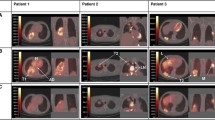Abstract
The present study evaluated the ability of the anti-GD2 ganglioside monoclonal antibody 3F8 to target tumor sites in patients with small-cell lung cancer (SCLC). Of 12 patients entered into the trial, ten received intravenous 3F8 labeled with 2 or 10 mCi iodine-131. The first five patients had recurrent or progressive disease after chemotherapy. Subsequent patients were studied before starting chemotherapy. Radionuclide scans were performed on days 1, 2, and 3 post-infusion and once between day 5 and day 7. Four patients underwent single-photon emission tomography (SPET) imaging. Radionuclide scans demonstrated localization to all known sites of disease, other than small brain metastases in one patient. SPET/CT scan fusion images confirmed precise localization. No significant toxicity was observed. Mean serum half-life was 64.2 h. Analysis of specimens from one patient who died of unrelated causes 6 days post-infusion confirmed the scan results. The present study demonstrates that 3F8 targets SCLC sites in patients. Further studies of anti-GD2 antibodies with higher doses of antibody and radionuclide are warranted to evaluate their role in SCLC.
Similar content being viewed by others
References
Cheresh DA, Rosenberg J, Mujoo K, et al. Biosynthesis and expression of the disialoganglioside GD2, a relevant target antigen on small cell lung carcinoma for monoclonal antibodymediated cytolysis.Cancer Res 1986; 46: 5112–5118.
Munn DH, Cheung NK. Interleukin-2 enhancement of monoclonal antibody-mediated cellular cytotoxicity (ADCC) against human melanoma.Cancer 1987; 47: 6600–6605.
Cheung N-KV, Lazarus H, Miraldi FD, et al. Ganglioside GD2 specific monoclonal antibody 3F8: a phase I study in patients with neuroblastoma and malignant melanoma.J Clin Oncol 1987; 5: 1430–1440.
Cheung NKV, Landmeier B, Neely J, et al. Complete tumor ablation with iodine 131-radiolabeled disialoganglioside GD2-specific monoclonal antibody against human neuroblastoma xenografted in nude mice.J Natl Cancer Inst 77:739–745.
CRS MIRD Pamphlet # 10. New York, Society of Nuclear Medicine, 1975, Sept.
Grant SC, Kostakoglu L, Pisters KMW, et al. Use of the MAb 3F8 in imaging small cell lung carcinoma.Lung Cancer 1991; 7 Suppl: A226.
Houghton AN, Mintzer D, Cordon-Cardo C, et al. Mouse monoclonal IgG3 antibody detecting GD3 ganglioside: a phase I trial in patients with malignant melanoma.Proc Natl Acad Sci USA 1985; 82: 1242–1246.
Cheung NKV; Lazarus H, Miraldi FD. Reassessment of patient response to monoclonal antibody 3F8.J Clin Oncol 1992; 10: 671–672.
Cheresh DA, Pierschbacher MD, Herzig MA, et al. Disialogangliosides GD2 and GD3 are involved in the attachment of human melanoma and neuroblastoma cells to extracellular matrix proteins.J Cell Biol 1986; 102: 688–696.
Cheresh DA, Harper JR, Schulz G, et al. Localization of the gangliosides GD2 and GD3 in adhesion plaques and on the surface of human melanoma cells.Proc Natl Acad Sci USA 1984; 81: 5767–5771.
Author information
Authors and Affiliations
Rights and permissions
About this article
Cite this article
Grant, S.C., Kostakoglu, L., Kris, M.G. et al. Targeting of small-cell lung cancer using the anti-GD2 ganglioside monoclonal antibody 3F8: A pilot trial. Eur J Nucl Med 23, 145–149 (1996). https://doi.org/10.1007/BF01731837
Received:
Revised:
Issue Date:
DOI: https://doi.org/10.1007/BF01731837




